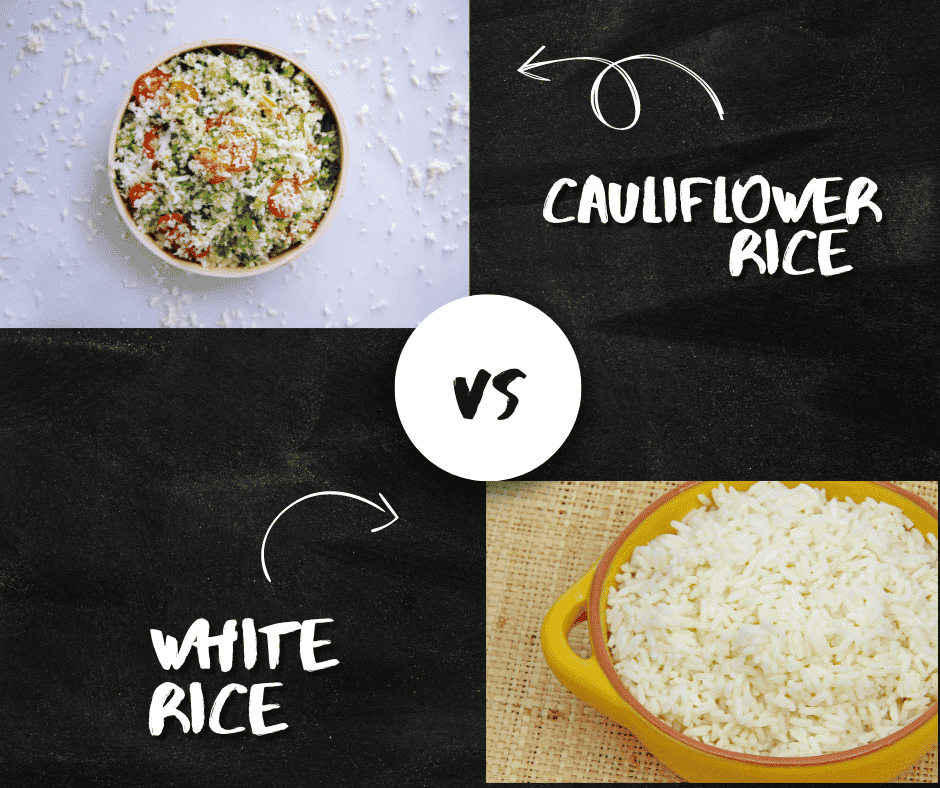Cauliflower rice and white rice are both popular for their neutral taste, which makes them easy to combine with other flavors. Both are also versatile options for home cooks, since they’re suitable for almost any meal and can be served as side dishes or used in place of grains in larger main dishes.
If you’re trying to reduce your intake of carbs while eating more vegetables, cauliflower rice and white rice are both good choices. They also each offer a different set of vitamins, minerals, and other nutrients that contribute to your overall health. Depending on your personal preferences and dietary needs, one may be a better fit for you than the other.

we’ll explore the differences between cauliflower rice Vs. white rice so that you can decide which one is the best fit for your diet and lifestyle.
Difference Between Cauliflower rice Vs. White rice
The main difference between Cauliflower rice and White rice is that Cauliflower rice is low in calories and carbs while White rice is high in both.
Here are 10 differences between white rice and cauliflower rice:
1. Calories
Cauliflower rice is lower in calories. A cup of cooked white rice has about 205 calories, while a cup of cauliflower rice has just 25 calories.
2. Carbs
Cauliflower rice is lower in carbs. A cup of white rice has about 44 grams of carbohydrates, while a cup of cauliflower rice has just 5 grams of carbohydrates.
3. Fiber
Cauliflower rice is a good source of fiber. A cup of white rice has about 1 gram of fiber, while a cup of cauliflower rice has about 2 grams of fiber.
4. Vitamins and Minerals
Cauliflower rice is a good source of vitamins and minerals. White rice is mostly composed of carbs and doesn’t have many vitamins or minerals. Cauliflower rice, on the other hand, is a good source of vitamins C, B6, and potassium.
5. Glycemic index
Cauliflower rice is lower on the glycemic index. The glycemic index is a measure of how quickly a food raises your blood sugar levels. Foods with a high glycemic index (such as white bread and white rice) are more likely to cause spikes in blood sugar, while foods with a low glycemic index (such as most vegetables) are less likely to do so.
6. Gluten-free
Cauliflower rice is gluten-free. White rice contains gluten, while cauliflower rice does not. This makes cauliflower rice a better choice for people with celiac disease or gluten sensitivity.
7. Filling
Cauliflower rice is more filling. One study found that people who ate cauliflower rice were more satisfied and felt fuller than those who ate white rice. This may be due to the higher fiber content of cauliflower rice.
8. Digest
Cauliflower rice is easier to digest. White rice can be difficult to digest for some people, while cauliflower rice is generally well-tolerated.
9. Usage
Cauliflower rice can be used in many different recipes. Cauliflower rice can be used as a substitute for white rice in most recipes. It can also be used in recipes that call for cooked rice, such as risotto or rice pudding.
10. Functions
Cauliflower rice is a good way to sneak more vegetables into your diet. If you’re looking for a way to eat more vegetables, cauliflower rice is a great option. It’s an easy way to add an extra serving of veggies to your day.
Conclusion
So, there you have it – 10 differences between white rice and cauliflower rice. When it comes to nutrition, cauliflower rice is the clear winner. It’s lower in calories and carbs, higher in fiber and vitamins, and more filling than white rice. If you’re looking for a healthy way to enjoy “rice” dishes, cauliflower rice is a great option.
Related Posts:

![Why Is My Rice Bubbling Like Soap? [Reasons & Solutions] 2 why is my rice bubbling like soap](https://ricecreamshoppe.com/wp-content/uploads/2023/04/why-is-my-rice-bubbling-like-soap-375x195.webp)






Leave a Comment